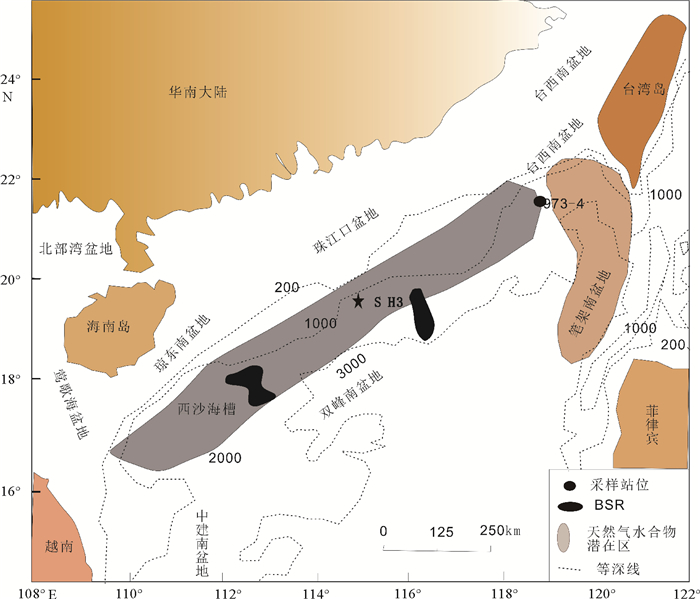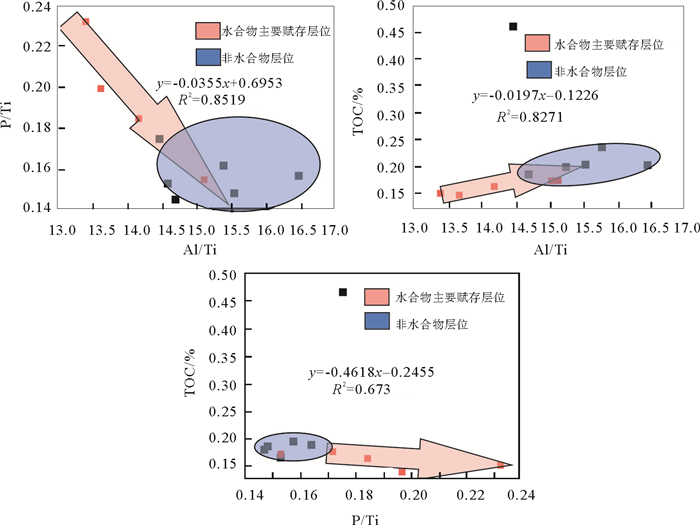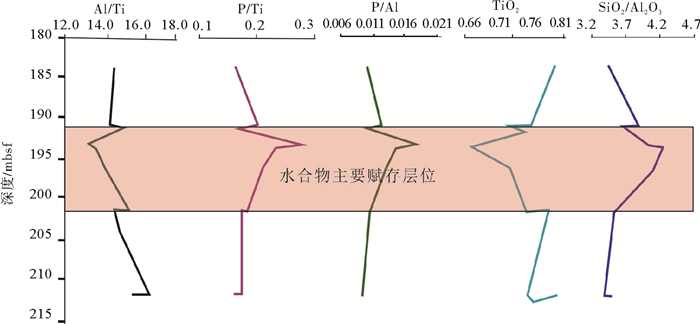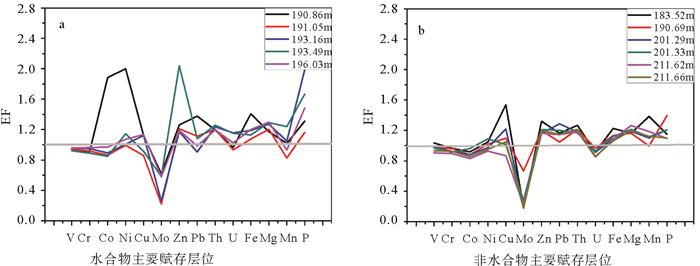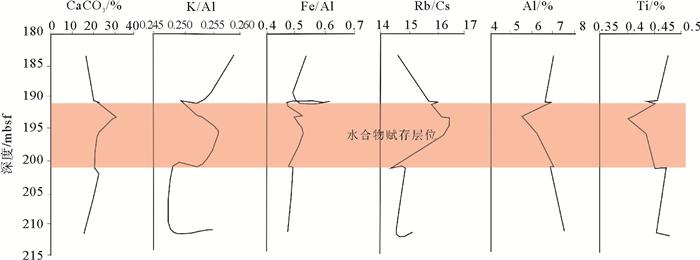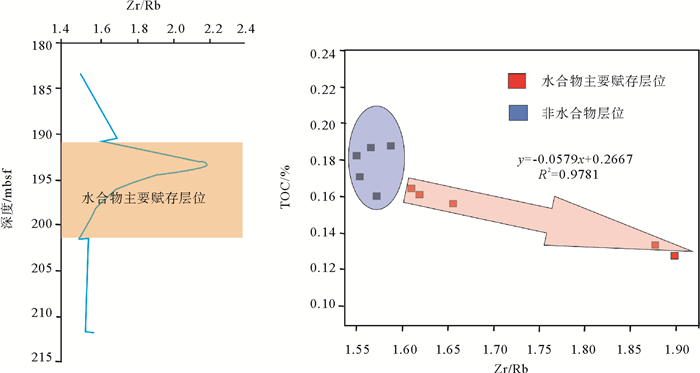Paleo-environment and paleo-productivity of the hydrate reservoirs in the Shenhu area of northern South China Sea
-
摘要: 天然气水合物作为一种新型的清洁能源,其形成需要稳定的有机质供应。南海北部神狐海域为天然气水合物成藏的有利区域,2017年中国地质调查局在神狐海域水合物试采获得突破性成功。为了进一步了解古环境和古生产率对形成水合物有机质供应的影响,对南海北部神狐海域水合物钻探区SH3站位180~215mbsf(meters below the sea floor)层位,尤其是水合物主要赋存层位190~200mbsf的古环境、古生产率以及陆源碎屑物质的地球化学指标进行分析研究。研究表明水合物主要赋存层位陆源碎屑物质(TDM)输入增加,较高的陆源碎屑物质输入和次氧化的沉积环境共同造就了比较好的有机质的外部保存条件;同时较强的水动力条件,有利于藻类生物的繁殖,因此,生物成因有机质比较丰富, 再加上神狐海域有比较良好的热解气的形成条件,这3个层面共同保证了神狐海域具有比较充足的有机质供应。Abstract: The accumulation of natural gas hydrate requires a stable supply of organic gas. The Shenhu area of the northern part of the South China Sea has been proved a favorable area for natural gas hydrates generation. In the year of 2017, the trial case of hydrate production made a breakthrough there. To further understand the influence of the paleo-environment and paleo- productivity onto organic preservation, this paper is specially devoted to the interval of 180-215 meters below the sea floor at the station of SH3, especially the horizon of 190-200mbsf of the main hydrate storage in the Shenhu area. Studies on the Paleo-environment, redox environment and terrigenous detrital material input suggests that the input of terrigenous detrital material (TDM) increase in the hydrate-bearing horizons and the suboxic depositional environments. The two factors jointly created a favorable external condition for storage and preservation of organic matters. At the same time, the stronger hydrodynamic conditions are conducive to the production of algae, and the biogenic organic gas is relatively abundant. Together with the better conditions for the formation of thermogenic gas, there are enough gas sources for the formation of gas hydrate deposits in the Shenhu area.
-
Keywords:
- paleo-productivity /
- paleo-environments /
- Shenhu area /
- gas hydrate
-
水体富营养化是我国近海生态系统面临的主要威胁之一[1]。南黄海位于西太平洋边缘,西南部有来自世界主要大河之一的长江输入,西侧江苏近岸是我国重要海水养殖区[2],其水体富营养化始于20世纪80年代,与人为活动引发的氮(N)、磷(P)等营养物质排放密切相关[3]。自2007年以来,南黄海富营养化环境等驱动的绿潮连年暴发,对山东和江苏沿岸生态环境和海水养殖等造成了严重危害[4]。在全球变暖和人为活动双重压力下,南黄海富营养化还促进了海水脱氧和酸化[5]。当前,南黄海富营养化研究主要关注水体营养元素,对沉积物营养物质再释放及其对水体富营养化态势影响的研究亟待加强。
研究显示南黄海富营养化从早期的N限制转换到近期的P和硅(Si)限制[6]。P是海洋生态系统中生物生长所必需的重要生源要素之一,是反映水体富营养化水平的主要因子,其生物地球化学循环过程与海洋资源的可持续利用和全球变化密切相关[7]。沉积物是海洋环境中磷的重要储库,既可接受来自水体沉降与颗粒物输运带来的磷,又可在适当条件下将其释放至上覆水体参与再循环,对水体富营养化态势具有重要长期影响[8]。沉积物总磷(TP)可反映磷在沉积物中的污染程度,磷的各种赋存形态是评估其迁移转化的重要依据。沉积物中部分形态磷易释放至水体,有的形态磷可长期埋藏,对水体中磷浓度和富营养化态势影响具有较大差异[9]。沉积磷可分为无机磷(IP)和有机磷(OP)2种形态,IP又可细分为可交换态磷(Ex-P)、铁结合态磷(Fe-P)、钙结合态磷(Ca-P)、原生碎屑态磷(De-P)等[10]。磷在沉积物中的赋存形态决定了其吸附、释放特性和稳定矿化程度,直接影响到水体中磷的浓度,是评估水体富营养化风险、预测内源磷负荷影响和解析沉积物磷来源的重要依据[11-13]。因此,研究沉积物中磷的含量水平和赋存形态分布特征对于探究沉积物-海水界面磷的循环过程、交换和补充机制,分析预测其生物有效性和潜在供磷能力具有重要意义[14]。本文聚焦南黄海,分析了表层沉积物中磷的含量水平、赋存形态和分布特征,解析了不同形态磷的来源及与环境因子的潜在关系,评估了磷的生物有效性和对富营养化态势的影响,以期为该海域营养盐的补充和转化机制提供新的线索。
1. 区域概况
黄海是介于中国大陆和朝鲜半岛的半封闭海域,以胶东半岛成山角到朝鲜的长山串连线将其分为北黄海和南黄海两部分,西北部通过渤海海峡与渤海相连,东部由济州海峡与朝鲜海峡相通,南以长江口东北岸启东角到济州岛西南角连线与东海分界[15]。黄海环流主要由黄海暖流(及其余脉)和沿岸流组成[16]。黄海暖流是该区海水的主要来源,具有高盐(冬季兼有高温)特征。黄海沿岸流包括西朝鲜沿岸流、辽南沿岸流、苏北近岸流等局部性沿岸流,均为低盐(冬季兼低温)水流。南黄海表层沉积物以陆源碎屑沉积为主,在黄海暖流、潮流、风暴潮和沿岸流等复杂水动力作用下进行分异,形成了细粒泥质沉积区、粗粒级砂质沉积区和混合沉积区,仅有部分区域出现含砾沉积物[17]。
2. 样品与方法
2.1 样品采集
2011年4月,搭载“科学三号”考察船在南黄海(33°~37°N、121°~124°E)范围内开展调查。如图1所示,调查布设采样断面5条,采样站位22个,站位水深为18~83 m,平均水深为54 m。采样方法、层次和测定方法均按《海洋调查规范》(GB/T 12763-2007)进行。用箱式采样器采集22个表层沉积物样品,取表层0~2 cm沉积物置于酸洗洁净的聚乙烯密封袋中,4℃下保存。
2.2 实验分析
将表层沉积物在60℃下烘干,恒重。TP测定:准确称取0.10 g干沉积物于550 ℃条件下灰化样品,用0.1 mol/L 的HCl充分溶解残渣后分取上部清液,以磷钼蓝分光光度法(上海元析UV-5500PC)进行测定;IP测定:准确称取0.10 g沉积物于100 mL塑料管中,加入25 mL 0.1 mol/L 的 HCl,振荡2 h后离心,分取5 mL上清液以磷钼蓝分光光度法进行测定;TP含量减去IP含量即为OP含量。形态磷采用改进的SEDEX连续提取方法[18](表1)测定:取约0.15 g样品,用MgCl2溶液(pH = 8)提取Ex-P,用CDB混合浸取液(柠檬酸钠-连二亚硫酸钠-碳酸氢钠缓冲液)(pH = 7.6)提取Fe-P,用醋酸-醋酸钠缓冲液(pH = 4)提取Ca-P,用盐酸提取De-P,在提取相之间用MgCl2淋洗,减少了磷的再吸附效应,每步浸取液用磷钼蓝分光光度法进行测定,并做试剂空白。本研究环境相关数据依据《海洋监测规范》(GB 17378-2007)中水体和沉积物分析方法对样品进行处理和测定:其中海水深度、温度、盐度和pH值以船载CTD传感器(海鸟SBE-911 plus)获得,可溶性硫化物以亚甲基蓝分光光度法(上海元析UV-5500PC)测定;沉积物粒度是将样品去除有机质和碳酸盐后,用激光粒度分析仪(Cilas 940L)测定,沉积物TOC是以重铬酸钾氧化-还原容量法化学滴定,实验所用试剂均为分析纯或分析纯以上试剂。采用Surfer和Excel等软件进行绘图和数据处理,采用SPSS20.0软件对实验数据进行统计和分析,利用Pearson相关性分析讨论不同磷形态及其与环境因子之间的相关性。
3. 结果
3.1 上覆水和沉积物理化特征
研究区内表层海水温度的变化范围为7.0 ~10.8 °C,平均温度为9.20 °C;底层海水温度的变化范围为5.20 ~10.7 °C,平均温度为8.10 °C。表层水体盐度为30.0~33.3,平均盐度为32.2;底层水体盐度为30.0~33.9,平均盐度为32.5。水体盐度和温度平面分布(图2a、b)显示,低温低盐冲淡水进入长江口外水域,与高温高盐的海水交汇混合,形成了水体盐度和温度沿冲淡水扩展方向由低到高的梯度变化。调查海区pH值在表层海水中变化范围为8.09~8.39,平均值为8.25;底层海水pH值变化范围为8.06~8.21,平均值为8.14。
南黄海表层沉积物黏土、粉砂和砂含量范围分别为6.84%~46.26%、19.58%~79.18%和0~73.59%,平均值分别为23.70%、56.42%和19.79%。受沿岸流影响,整体呈现出由沿岸区域向中部海域逐渐变细的分布趋势,粉砂组分高值主要集中在沿岸和东北区域,低值位于北部中央区域和南部外海区域;黏土组分高值出现在东北区域和中部泥质区(图3a)。细颗粒物质(黏土+粉砂)占80.2%以上,四周低,中央高,与中值粒径显著正相关(r=0.878,p<0.01)。G1和I4两个站位的优势粒径为砂组分,所占比例分别为73.6%和57.4%,远大于其他站点,沉积物TOC在这两个站点呈现低值。研究区内TOC含量变化范围为0.19%~1.42%,平均值为0.58%,高值出现在细颗粒为主的黄海中部泥质区。基于Shepard分类法[19](图4),研究区内表层沉积物主要成分为黏土质粉砂和砂质粉砂,仅部分站位为粉砂质砂和粉砂。
3.2 沉积物中总磷和形态磷
南黄海表层沉积物中TP和各形态磷含量分布如图5所示。TP含量范围为390~630 mg/kg,平均值为514 mg/kg,最高值出现在C5站,最小值出现在A2站。根据TP含量500 mg/kg和1300 mg/kg作为沉积物轻污染、中等污染和重污染的界限标准[20-21],南黄海沉积P基本处于轻度污染,部分站位处于中度污染。IP包括Ex-P、Fe-P、Ca-P和De-P,质量浓度范围为242.38~465.26 mg/kg,平均含量为346.99 mg/kg,最高值在C5站,最低值在G6站。Ex-P含量变化范围为4.93~27.71 mg/kg,平均值为15.07 mg/kg,最高值出现在G4站,最小值出现在C1站;Fe-P含量变化范围为25.41~133.82 mg/kg,平均值为57.96 mg/kg,最高值出现在C5站,最小值出现在I3站;Ca-P含量变化范围为79.26~235.06 mg/kg,平均值为155.18 mg/kg,最高值在E2站,最低值在C2站;De-P含量为82.08~195.09 mg/kg,平均值为118.78 mg/kg,最高值出现在I2站,最小值出现在C5站。OP含量变化范围为3.98~230.59 mg/kg,平均值为167.10 mg/kg,最高值出现在G2站,最小值出现在C1站。
4. 讨论
4.1 磷的分布与来源
沉积物各形态P呈现出多种不同空间分布模式(图5),这不仅与物质来源有关,而且受沉积物粒度效应、有机质含量、氧化还原环境、沉积速率和人类活动等因素影响,且不同形态P受控程度不同[22-25]。南黄海表层沉积物中TP呈现出离岸越近、含量越高的趋势,具有明显的陆源输入分布特征。TP中不同形态P平均贡献为OP>Ca-P>De-P>Fe-P>Ex-P。TP与IP(r=0.639,p<0.01)、OP(r=0.480,p<0.05)、Ex-P(r=0.526,p<0.05)、Fe-P(r=0.512,p<0.05)和Ca-P(r=0.519,p<0.05)均呈显著正相关关系(表2),其中TP与IP的相关系数要明显高于其他形态,说明IP对TP含量水平与分布特征的贡献和影响更显著,这与IP在TP的高占比(约76.39%)相符合(图6)。
表 2 南黄海表层沉积物中各形态磷相关性Table 2. Correlation among various phosphorus forms in the surface sediments of South Yellow Sea参数 TP IP OP Ex-P Fe-P Ca-P De-P TP 1 IP 0.639** 1 OP 0.480* −0.368 1 Ex-P 0.526* 0.423 0.154 1 Fe-P 0.512* 0.595** −0.059 0.727** 1 Ca-P 0.519* 0.907** −0.408 0.222 0.470* 1 De-P 0.085 0.271 −0.207 −0.271 −0.457* 0.082 1 注:**:p<0.01,*:p<0.05。 IP包括Ex-P、Fe-P、Ca-P和De-P,主要来自生活污水和工业废水,与区域地质-地球化学背景和人类活动密切相关,受pH值影响较大,对氧化还原电位等沉积环境改变较敏感,其迁移转化是沉积物向上覆水释放磷的主要机制之一[9, 20, 26-27]。IP与Fe-P(r=0.595,p<0.01)和Ca-P(r=0.907,p<0.01)显著正相关(表2),说明Fe-P和Ca-P是影响IP含量与分布的主要形态。Fe-P与Ex-P(r=0.727,p<0.01)和Ca-P(r=0.470,p<0.05)也具有显著正相关关系(表2),说明它们可能具有相似的来源或地球化学行为。
Ex-P指可弱吸附和交换的存在于孔隙水的磷,是沉积物中最活性、变化范围最大的形态[28],pH、温度、水体动力、氧化还原环境和生物扰动等可使其通过再悬浮或渗透带至上覆水,直接参与生态系统循环[29-30]。本研究中,Ex-P占TP的1.20%~4.56%,平均值为2.91%,在4种IP形态中含量最低,占TP的比值也最低,其中C1站占比最小,E4站占比最大(图6)。通过物理吸附于颗粒物表面的Ex-P,随着有机物降解释放至沉积物矿物表面[31],与沉积物黏土组分含量显著正相关(r=0.426,p<0.05)(图7a),说明粒度是影响其含量和分布的重要因素[32-33],细颗粒物质拥有较大比表面积,为磷酸盐的吸附提供了更多结合位点[8]。值得关注的是,Ex-P含量与表层水体pH值显著正相关(r=0.564,p<0.01,表3),推测南黄海底层海水酸化趋势[5](pH降低)可能促进了沉积物中Ex-P向海水释放,加剧海水富营养化程度。
表 3 南黄海表层沉积物中形态磷与环境参数相关性Table 3. Correlation among various phosphorus forms and environmental parameters in the surface sediments of South Yellow Sea参数 TP IP OP Ex-P Fe-P Ca-P De-P 水深 −0.317 −0.107 −0.261 0.320 0.503* −0.087 −0.682** 表层海水硫化物 0.368 0.148 0.273 0.029 0.092 0.025 0.208 底层海水硫化物 0.223 0.228 −0.003 0.342 0.535* 0.133 −0.256 表层海水温度 0.280 0.124 0.196 0.121 0.050 0.071 0.106 底层海水温度 0.349 0.206 0.188 −0.041 −0.134 0.171 0.354 表层海水盐度 −0.192 0.023 −0.258 0.209 0.359 −0.051 −0.260 底层海水盐度 −0.192 0.001 −0.233 0.271 0.415 −0.071 −0.347 表层海水pH值 −0.079 −0.055 −0.033 0.564** 0.602** −0.092 −0.687** 底层海水pH值 −0.049 −0.168 0.133 0.053 0.020 −0.274 −0.006 注:**:p<0.01; *:p<0.05。 Fe-P主要指吸附于铁锰氢氧化物的磷,是迁移转化的重要形态,氧化还原条件、pH和生物作用等均可影响其稳定性[34],可指示磷的来源并作为环境污染程度的指标[35]。本研究中,Fe-P占TP的5.19%~21.24%(图6),在4种IP形态中占比仅高于Ex-P。Fe-P与黏土组分显著正相关(r=0.667,p<0.01),与砂组分显著负相关(r=−0.510,p<0.05)(图7b),说明细颗粒为磷酸盐吸附在铁氧表面提供了更多结合位点[31, 36]。Fe-P高值通常出现在有明显河流输入的沿岸地区,如密西西比河[37]和长江口区域[38]。从淡水区到海水,水体盐度和pH值升高,磷酸盐存在形式由H2PO4-到HPO42-,表面电荷的改变抑制了磷酸盐在铁氧表面的吸附[39]。Fe-P与水深(r=0.530,p<0.05)、pH(r=0.602,p<0.01)和硫化物(r=0.535,p<0.05)均具有显著正相关关系(表3),说明深水、高pH值和还原环境等均能促进Fe-P在沉积物中富集。南黄海底层海水酸化趋势[5]将促使沉积物中Fe-P向海水释放,加剧海水富营养化程度。
Ca-P主要指自身成因和生物成因的自生磷灰石磷及与自生碳酸钙共沉淀的磷(包括水体中的生物残骸),一般形成于生物骨骼碎屑或海洋成岩作用,是一种海洋源的沉积磷[40-42],在本研究中占TP的16.18%~48.33%,平均值为30.17%,最低比例在C2站,最高比例在C1站(图6)。从含量看,Ca-P是IP主导形态,说明海洋源P是该区域沉积P的重要来源。Ca-P与分析的环境参数均无相关性(表3、图7c),说明其不易受控于周边环境的影响,也反映其在沉积物中稳定性较强,不易参与再循环。
De-P指原生碎屑磷,主要来源于流域内风化侵蚀产物中磷灰石矿物晶屑等,可反映流域内侵蚀速率大小及侵蚀程度强弱[43-44],在本研究中占TP的13.03%~34.23%,平均值为23.46%,最小比例在C5站,最大比例在I2站,是IP第二主导形态(图6),其比例小于具有明显大河输入的长江口、东海陆架区[38, 45]和渤海[46]。在长江冲淡水北向分支流经的西南方向出现高值,说明De-P与陆源物质输运有关,在冲淡水的携带下向外搬运[47]。De-P含量与细颗粒黏土组分显著负相关(r=−0.459,p<0.05,图7d),说明其在细颗粒沉积物中含量较少,这是因为其属于颗粒物内部的碎屑矿物,主要存在于粗颗粒物中,含量随沉积物粒径的增大而增加。
研究区内OP/TP小于IP/TP,OP作为沉积磷和有机质重要组分,在微生物和酶作用下转化为生物活性磷,是水体生物可利用磷的重要来源[48]。OP占TP的12.54%~48.97%,平均值为32.35%(图6),主要源自陆源输入和生物过程[46, 49]。OP占比高值常出现在有机碳丰富的泥质区,与沿岸污水、农业和水产业流出物有关[50]。研究区东北部OP高值可能是因为该区具有较高的生产力,富含有机物的生物有机体残骸沉降于此(图5)。海洋沉积物有机碳和磷摩尔比(OC/OP)可解释沉积磷行为,区分有机质来源[51-53]。新鲜海洋浮游生物OC/OP比值为106,陆源植物比值介于800~2050之间[54]。本研究中,OC/OP比值变化范围为27~260,平均比值为96,大多数站位该比值小于106(图8),说明到达沉积物-水体界面的有机质并非新生的海洋碎屑物质,出现在近岸地区的OC/OP高值显示了陆源输入的主导作用,而远岸地区的高值是由于在早期成岩时期有机质的氧化降解过程中P优先再生[40]。
4.2 沉积P的再释放趋势及其对富营养化态势的影响
TP浓度难以准确反映沉积磷的地球化学行为,而不同形态磷对水体磷负荷贡献存在显著差异。生物有效磷(BAP)是指易从沉积物中释放,对水体磷含量和分布影响大的组分。沉积物中Ex-P最具生物可利用性;当Fe3+被还原成Fe2+时,Fe-P会被释放,具有重要潜在生物有效性[29];OP随着微生物再矿化作用释放为可溶解IP被生物利用[37];Ca-P在近岸物理化学条件下几乎不溶解,是不易被生物利用的形态[55];De-P来源于变质岩中的磷灰石,难以被生物利用。因此,Ex-P、Fe-P和OP通过一定物理、化学和生物过程可被释放,属于BAP,代表可释放至上覆水体磷的上限[56] ,是调控水体富营养化态势的重要因素。
南黄海表层沉积物BAP(Ex-P + Fe-P + OP)含量变化范围为103.3~363.6 mg/kg,平均值为240.1 mg/kg,占TP的25.2%~60.4%,平均占比为46.4%。BAP构成了南黄海沉积P的主要组成部分,其中黄海中部泥质区南端G4处BAP含量最高,BAP/TP比例也最高(图9)。研究区内BAP含量南部大于北部,与OP分布特征相似,说明OP是BAP的主要组成部分。总的来说,南黄海表层沉积物中BAP的高含量(240.1 mg/kg)和高占比(46.4%)均说明该区域沉积P具有较强的再释放潜能,尤其是在底层海水酸化的背景下,可显著加剧区域水体富营养化态势。
5. 结论
(1)南黄海表层沉积物TP含量为390~630 mg/kg,均值为514 mg/kg,总体处于轻度污染,部分站位处于中度污染,陆源输入和生物过程是影响TP含量分布的主要因素。
(2)南黄海表层沉积物不同形态P平均贡献为OP>Ca-P>De-P>Fe-P>Ex-P。TP以IP为主,而后者又主要由Ca-P和De-P组成。沉积物粒度、海水pH值、氧化还原状况等环境因素是影响沉积P向水体释放的重要因素,海水酸化可能促进Ex-P和Fe-P向上覆海水释放。
(3)BAP包括Fe-P、Ex-P和OP,平均含量240.1 mg/kg,约占TP的一半。较高的生物可利用P水平说明南黄海沉积P具有较强的再释放潜能,在海水酸化等环境影响下可加剧水体富营养化态势。南黄海是我国绿潮孕育和爆发的主要场所,未来的海水富营养化形成演化和绿潮等海洋灾害控制研究应着重关注沉积P的再释放过程及其生态环境效应。
致谢: 本次研究样品由广州海洋地质调查局于2007年在南海北部陆坡神狐海域实施“中国海域天然气水合物钻探”(GMGS1)航次获得,感谢该航次科学家们为研究样品的获得付出的辛勤劳动;感谢中国科学院广州能源研究所分析测试中心、武汉上谱分析科技有限责任公司和中国科学院广州地球化学研究所为本文研究提供的测试。 -
图 1 神狐海域钻探区分布图及SH3站位分布位置地形地质图(改编自文献[15])
Figure 1. Tectonic map of subareas of the Shenhu drilling area. Note the location of SH3
表 1 神狐海域钻探区水合物油气体系(SH2、SH3和SH7站位的地球化学数据据文献[3, 25])
Table 1 Characteristics of the gas-hydrate petroleum system in the Shenhu drilling area highlighting the distinct differences between the three sites
站位 水合物稳定条件 气体组成以及气体来源 气体运移体系 SH2 海底温度:4.84℃
海底压力:12.46MPa
水深:1245mCH4:99.89%;δ13C1:-56.7%,生
物气为主导的混合气气烟囱伴有很多微小的断层;低甲
烷通量SH3 海底温度: 5.53℃
海底压力: 12.61MPa
地热梯度: 49.34℃/kmδ13C1: -61.6%, 生物气为主导的
混合气气烟囱伴有很多微小的断层;低甲
烷通量SH7 海底温度: 6.44℃
海底压力: 11.20MPa
地热梯度: 43.65℃/km生物气为主导的混合气 微小断层;低甲烷通量 表 2 主、微量元素随深度的分布
Table 2 Distribution of major and trace elements with depth
深度/mbsf Al/% Si/% Ti/% P/% TOC/% V/×10-6 Cr/×10-6 Ni/×10-6 Th/×10-6 U/×10-6 Mo/×10-6 Co/×10-6 183.52 6.977 21.285 0.476 0.070 0.181 95.959 69.624 39.928 11.778 2.213 0.242 13.5 190.69 6.584 22.489 0.455 0.080 0.464 85.453 65.464 36.708 10.628 2.246 0.819 12.3 190.86 6.572 21.073 0.436 0.075 0.171 81.188 61.827 71.951 10.444 2.142 0.759 26.2 191.05 6.813 21.706 0.451 0.069 0.175 85.115 64.530 37.070 10.908 2.163 0.278 12.5 193.16 5.490 19.593 0.409 0.095 0.145 70.181 53.829 30.255 9.022 2.304 0.268 10.4 193.49 5.513 20.501 0.403 0.080 0.137 67.611 50.653 34.531 9.225 2.125 0.603 9.9 196.02 6.194 22.299 0.436 0.080 0.166 78.922 61.643 36.370 9.842 2.058 0.668 12.7 201.29 6.943 21.585 0.451 0.073 0.193 90.242 66.371 36.960 10.909 2.134 0.270 13.0 201.33 6.845 20.971 0.470 0.072 0.170 88.183 64.591 40.737 10.650 2.130 0.356 13.9 211.62 7.457 22.312 0.453 0.071 0.197 89.906 68.959 37.797 11.755 2.217 0.300 13.1 211.66 7.405 22.836 0.477 0.071 0.198 91.907 70.742 38.436 11.959 2.200 0.245 13.4 最小值 5.490 19.593 0.403 0.069 0.137 67.611 50.653 30.255 9.022 2.058 0.242 9.880 最大值 7.457 22.836 0.477 0.095 0.464 95.959 70.742 71.951 11.959 2.304 0.819 26.179 平均值 6.618 21.514 0.447 0.076 0.200 84.061 63.476 40.068 10.647 2.176 0.437 13.702 表 3 氧化物指标及各元素比值
Table 3 Oxide indexes and ratios of elements
深度/mbsf Al2O3 /% TiO2 /% SiO2/% Al/Ti P/Al p/Ti SiO2/Al2O3 V/Cr V/Ni U/Th U/Mo Ni/Co 183.52 13.179 0.793 45.676 14.658 0.010 0.147 3.466 1.378 2.403 0.188 9.152 2.947 190.69 12.437 0.758 48.260 14.470 0.012 0.176 3.880 1.305 2.328 0.211 2.742 2.995 190.86 12.414 0.727 45.221 15.073 0.011 0.172 3.643 1.313 1.128 0.205 2.822 2.748 191.05 12.869 0.752 46.579 15.106 0.010 0.153 3.619 1.319 2.296 0.198 7.789 2.976 193.16 10.370 0.682 42.045 13.423 0.017 0.232 4.054 1.304 2.320 0.255 8.596 2.914 193.49 10.414 0.672 43.994 13.680 0.015 0.199 4.225 1.335 1.958 0.230 3.526 3.494 196.02 11.700 0.727 47.852 14.206 0.013 0.183 4.090 1.280 2.170 0.209 3.082 2.870 201.29 13.115 0.752 46.320 15.395 0.011 0.162 3.532 1.360 2.442 0.196 7.907 2.850 201.33 12.930 0.783 45.002 14.564 0.011 0.153 3.481 1.365 2.165 0.200 5.985 2.925 211.62 14.086 0.755 47.880 16.461 0.010 0.157 3.399 1.304 2.379 0.189 7.392 2.890 211.66 13.988 0.795 49.004 15.524 0.010 0.149 3.503 1.299 2.391 0.184 8.980 2.868 min 10.370 0.672 42.045 13.423 0.010 0.147 3.399 1.280 1.128 0.184 2.742 2.748 max 14.086 0.795 49.004 16.461 0.017 0.232 4.225 1.378 2.442 0.255 9.152 3.495 ave 12.500 0.745 46.167 14.778 0.012 0.171 3.717 1.324 2.180 0.206 6.179 2.953 -
[1] Collett T S. Natural gas hydrate of the Prudhoe bay and Kuparuk River area, north slope Alaska [J]. AAPG Bulletin, 1993, 77(5): 793-812.
[2] Collett T S, Dallimore S R. Detailed analysis of gas hydrate roceinduced drilling and production hazardsd [R]. Proceedings of the 4th International Conferenceon Gas Hydrates, 2002, 73: 47-52.
[3] Wu N Y, Zhang H Q, Yang S X, et al. Gas hydrate system of Shenhu area, northern South China Sea: geochemical results [J]. Journal of Geological Research, 2011, 27: 1-10.
[4] Wu J F, Sunda W, Boyle E A, et al. Phosphate depletion in the western North Atlantic Ocean [J]. Science, 2000, 289: 759-762. doi: 10.1126/science.289.5480.759
[5] Miao Q, Thunell R C. Late Pleistocene-Holocene distribution of deep-sea benthic foraminifera in the South China Sea[R]: Paleoceanography implications[J]. Journal of Foraminifera Research, 1996, 26(1): 9-23.
[6] Zhang S L, Chen D F, Huang J Q. Conditions of accumulation of gas hydrate in Baiyun Sag [J]. Natural Gas Industry, 2007, 27: 7-10. http://www.wanfangdata.com.cn/details/detail.do?_type=perio&id=trqgy200709002
[7] 吴能友, 邬黛黛, 陈雪刚, 等.南海东北部东沙海域沉积物烃类有机地球化学研究及其意义[J].南海地质研究, 2007, 23: 1-14. http://www.cqvip.com/Main/Detail.aspx?id=29623366 WU Nengyou, WU Daidai, CHEN Xuegang, et al. Hydrocarbon organic geochemistry of sediments in the Dongsha area of the northeastern South China Sea and its significance[J]. South China Sea Geological Research, 2007, 23: 1-14. http://www.cqvip.com/Main/Detail.aspx?id=29623366
[8] 陈多福, 姚伯初, 赵振华, 等.珠江口和琼东南盆地天然气水合物形成和稳定分布的地球化学边界条件及其分布区[J].海洋地质与第四纪地质, 2001, 21(4): 73-78. http://hydz.chinajournal.net.cn/WKD/WebPublication/paperDigest.aspx?paperID=b820ad45-6ebd-45ea-b8e7-2f0f5a143172 CHEN Duofu, YAO Bochu, ZHAO Zhenghua, et al. Geochemical boundary conditions and distribution of natural gas hydrate formation in the Pearl River Estuary and Qiongdongnan basin[J]. Marine Geology and Quaternary Geology, 2001, 21(4): 73-78. http://hydz.chinajournal.net.cn/WKD/WebPublication/paperDigest.aspx?paperID=b820ad45-6ebd-45ea-b8e7-2f0f5a143172
[9] 邬黛黛, 吴能友, 张美, 等.东沙海域SMI与甲烷通量的关系及对水合物的指示[J].地球科学-中国地质大学学报, 2013, 38(6): 1309-1320. http://d.old.wanfangdata.com.cn/Periodical/dqkx201306014 WU Daidai, WU Nengyou, ZHANG Mei, et al. Relationship between SMI and methane fluxes in the Dongsha sea and their indications for hydrates [J]. Earth Science-Journal of China University of Geosciences, 2013, 38(6): 1309-1320. http://d.old.wanfangdata.com.cn/Periodical/dqkx201306014
[10] 刘昌玲, 孟庆国, 李承峰, 等.南海北部陆坡天然气水合物及其赋存沉积物特征[J].地学前缘, 2017, 24(4): 41-50. http://d.old.wanfangdata.com.cn/Periodical/dxqy201704005 LIU Changling, MENG Qingguo, LI Chengfeng, et al. Characteristics of gas hydrates and sedimentary sediments in the northern slopes of the South China Sea[J]. Earth Science Frontier, 2017, 24(4): 41-50. http://d.old.wanfangdata.com.cn/Periodical/dxqy201704005
[11] 苏丕波, 梁金强, 付少英, 等.南海北部天然气水合物成藏地质条件及成因模式探讨[J].中国地质, 2017, 44(3): 415-427. http://d.old.wanfangdata.com.cn/Periodical/zgdizhi201703001 SU Pibo, LIANG Jingqiang, FU Shaoying, et al. Geological conditions and genetic models of gas hydrate accumulation in the northern South China Sea[J]. Chinese Geology, 2017. 44(3): 415-427. http://d.old.wanfangdata.com.cn/Periodical/zgdizhi201703001
[12] Archer D, Buffett B, Brovkin V. Ocean methane hydrates as a slow tipping point in the global carbon cycle [J]. Proceedings of the National Academy of Sciences of the United States of America-Physical Sciences, 2009, 106: 20596-20601. http://www.wanfangdata.com.cn/details/detail.do?_type=perio&id=af0285ca07b3ed347305c74d17785596
[13] Tyson R V. Sedimentation rate, dilution, preservation and total organic carbon: some results of a modelling study [J]. Organic Geochemistry, 2001, 32: 333-339. doi: 10.1016/S0146-6380(00)00161-3
[14] Wan Z X, Xu X, Wang B, et al. Geothermal analysis of boreholes in the Shenhu gas hydrate drilling area, northern South China Sea: Influence of mud diapirs on hydrate occurrence [J]. Journal of Petroleum Science and Engineering, 2017, 158: 424-432. doi: 10.1016/j.petrol.2017.08.053
[15] Ding X J, Liu G D, Lu X J, et al. The impact on organic matter preservation by the degree of oxidation and reduction and sedimentation rates of Erlian Basin [J]. Natural Gas Geoscience, 2014, 25: 810-817. http://d.old.wanfangdata.com.cn/Periodical/trqdqkx201406003
[16] Li W H, Zhang Z H, Li Y C. Some aspects of excellent marine source rock formation: implications on enrichment regularity of organic matter in continental margin basins [J]. Chinese Journal of Geochemistry. 2015, 34: 47-54. doi: 10.1007/s11631-014-0018-2
[17] Tyson R V, Pearson T H. Modern and ancient continental shelf anoxia: An overview [J]. Geological Society of London Special Publication, 1991, 58: 1-24. doi: 10.1144/GSL.SP.1991.058.01.01
[18] 董军社, 陈平富.南海北部陆架晚第三纪δ13C记录与古生产力[J].海洋地质与第四纪地质, 1997, 17(1): 40-44. http://hydz.chinajournal.net.cn/WKD/WebPublication/paperDigest.aspx?paperID=ba13178e-487a-4690-9faa-32257f5c7506 DONG Junshe, CHEN Pingfu. Neogene carbon isotope records from the northern south china sea and their bearing on paleoproductivity. [J]. Marine Geology and Quaternary Geology, 1997, 17(1): 40-44. http://hydz.chinajournal.net.cn/WKD/WebPublication/paperDigest.aspx?paperID=ba13178e-487a-4690-9faa-32257f5c7506
[19] 黄宝琦.南海东北部晚第四纪古生产力变化[J].海洋地质与第四纪地, 2000, 20(2): 65-68. http://d.old.wanfangdata.com.cn/Periodical/hydzydsjdz200002011 HUANG Baoqi. Changes of Late Quaternary productivity in the northeastern South China Sea[J]. Marine Geology and Quaternary Geology, 2000, 20(2): 65-68. http://d.old.wanfangdata.com.cn/Periodical/hydzydsjdz200002011
[20] 李建, 王汝建.南海北部一百万年以来的表层古生产力变化:来自ODP1144站的蛋白石记录[J].地质学报, 2004, 78(2): 228-233. doi: 10.3321/j.issn:0001-5717.2004.02.012 LI Jian, WANG Rujian. Changes in surface productivity in the northern South China Sea over 1 million years: Opal records from ODP 1144 station [J]. Geological Journal, 2004, 78(2): 228-233. doi: 10.3321/j.issn:0001-5717.2004.02.012
[21] 李鹤, 黄宝琦, 王娜.南海北部MD12-3429站位海水古生产力和溶解氧含量特征[J].古生物学报, 2017, 56(2): 238-248. http://www.wanfangdata.com.cn/details/detail.do?_type=perio&id=gswxb201702010 LI He, HUANG Baoqi, WANG Na. Palo- Productivity and dissolved oxygen contents in the seawater of MD12-3429 station in the northern South China Sea[J]. Acta Palaeontologica Sinica, 2017, 56(2): 238-248. http://www.wanfangdata.com.cn/details/detail.do?_type=perio&id=gswxb201702010
[22] 吴聪, 陈炽新, 陈芳, 等.南海北部陆坡SH1B孔MIS6期以来的古生产力和古环境变化的硅藻记录[J].海洋地质与第四纪地质, 2015, 35(5): 95-102. http://hydz.chinajournal.net.cn/WKD/WebPublication/paperDigest.aspx?paperID=09fe8f87-0723-4897-b010-b9c351f3b2c6 WU Cong, CHENG Zhixing, CHENG Fang, et al. The paleo-productivity and paleo-environmental change of diatom records since the MIS6 period of the SH1B hole in the northern slope of the South China Sea [J]. Marine Geology and Quaternary Geology, 2015, 35(5): 95-102. http://hydz.chinajournal.net.cn/WKD/WebPublication/paperDigest.aspx?paperID=09fe8f87-0723-4897-b010-b9c351f3b2c6
[23] Zhu Y H, Su P B. Gas sources of natural gas hydrates in the Shenhu drilling area, South China Sea: geochemical evidence and geological analysis [J]. Journal of the Geological Society of China, 2013, 87(3): 767-776. http://www.wanfangdata.com.cn/details/detail.do?_type=perio&id=dzxb-e201303014
[24] Li S J, Chu F Y, Fang Y X, et al. Associated interpretation of sub-bottom and single-channel seismic profiles from slope of Shenhu Area in the northern South China Sea: Characteristics of gas hydrate sediment [J]. Journal of Tropical Oceanography, 2010, 29(4): 56-62. http://www.jto.ac.cn/en/y2010/v29/i4/56
[25] Su M, Yang R, Wu N Y, et al. Structural characteristics in the Shenhu area, northern continental slope of South China Sea, and their influence on gas hydrate [J]. Acta Geologica Sinica, 2014, 88(3): 318-326. http://en.cnki.com.cn/Article_en/CJFDTOTAL-DZXE201403002.htm
[26] Liang J Q, Wang H B, Su X, et al. Natural gas hydrate formation conditions and the associated controlling factors in the northern slope of the South China Sea [J]. Natural Gas Industry, 2014, 34(7): 128-135. http://www.wanfangdata.com.cn/details/detail.do?_type=perio&id=trqgy201407022
[27] Zhong Z H, Shi H S, Zhu M, et al. A discussion on the tectonic-stratigraphic framework and its origin mechanism in Pearl River Mouth Basin [J]. China Offshore Oil and Gas, 2014, 26(5): 20-29. http://www.wanfangdata.com.cn/details/detail.do?_type=perio&id=zghsyq-gc201405004
[28] Zhu W L, Huang B J, Mi L J, et al. Geochemistry, origin, and deep-water exploration potential of natural gases in the Pearl River Mouth and Qiongdongnan basins, South China Sea [J]. American Association of Petroleum Geologists Bulletin, 2009, 93: 741-761. doi: 10.1306/02170908099
[29] Lin C C, Lin A S, Liu C S, et al. Canyon-infilling and gas hydrate occurrences in the frontal fold of the offshore accretionary wedge off southern Taiwan [J]. Marine Geophysical Research, 2013, 12: 11-18. http://www.wanfangdata.com.cn/details/detail.do?_type=perio&id=5ac0b035e8ba97e25d4a8c2a9f5dc2e8
[30] Liu C S, Huang I L, Teng L S. Structural features off southwestern Taiwan [J]. Marine Geology, 1997, 137: 305-319. doi: 10.1016/S0025-3227(96)00093-X
[31] Suess E, Huang Y Y, Wu N Y, et al. Cruise report SO-177, Sino-German cooperative project, South China Sea. in: distribution, formation and effect of methane & gas hydrate on the environment[R]. 2004.
[32] Han X, Suess E, Huang Y, et al. Jiulong methane reef: microbial mediation of seep-carbonates in the South China Sea[J]. Marine Geology, 2008, 248(3-4): 243-256. doi: 10.1016-j.margeo.2007.11.012/
[33] Tyrrell T. The relative influences of nitrogen and phosphorus on oceanic primary production [J]. Nature, 1999, 400: 525-531. doi: 10.1038/22941
[34] Falkowski P G. Evolution of the nitrogen cycle and its influence on the biological sequestration of CO2 in the ocean [J]. Nature, 1997, 387: 272-275. doi: 10.1038/387272a0
[35] Luo Q Y, Zhong N N, Zhu L, et al. Correlation of burial organic carbon and paleoproductivity in the Mesoproterozoic Hongshuizhuang Formation, northern North China [J]. Chinese Science Bulletin, 2013, 58: 1299-1309. doi: 10.1007/s11434-012-5534-z
[36] Li W, Zhang Z. Paleoenvironment and its control of the formation of oligocene marine source rocks in the deep-water area of the northern South China Sea [J]. Energy & Fuels, 2017, 31(10): 10598-10611. http://www.wanfangdata.com.cn/details/detail.do?_type=perio&id=338a30a1c81365416408fe4406e675a8
[37] Murray R W, Knowlton C, Leinen M, et al. Export production and carbonate dissolution in the central equatorial Pacific Ocean over the past 1 Myr [J]. Paleoceanography, 2000, 15: 570-592. doi: 10.1029/1999PA000457
[38] Algeo T J, Kuwahara K, Sano H, et al. Spatial variation in sediment fluxes, redox conditions, and productivity in the Permian-Triassic Panthalassic Ocean [J]. Paleogeography, Paleoclimatology, Paleoecology, 2011, 308: 65-83. doi: 10.1016/j.palaeo.2010.07.007
[39] Li Y T, Zhang G S, Ellis, et al. Depositional environment and organic matter accumulation of Upper Ordovician-Lower Silurian marine shale in the Upper Yangtze Platform, South China [J]. Paleogeography, Paleoclimatology, Paleoecology, 2017, 466: 252-264. doi: 10.1016/j.palaeo.2016.11.037
[40] Li D, Li R, Zhu Z, et al. Origin of organic matter and paleo-sedimentary environment reconstruction of the Triassic oil shale in Tongchuan City, southern Ordos Basin (China) [J]. Fuel, 2017, 208: 223-235. doi: 10.1016/j.fuel.2017.07.008
[41] Mclennan. relationship between the trace element composition of sedimentary rocks and upper continental crust [J]. Geochemistry, Geophsics, Geosystem, 2011, 73: 181-187.
[42] Li N, Feng D, Chen L, et al. Compositions of foraminifera-rich turbidite sediments from the Shenhu area on the northern slope of the South China Sea: Implication for the presence of deep water bottom currents [J]. Journal of Asian Earth Sciences, 2017, 138: 148-160. doi: 10.1016/j.jseaes.2017.02.010
[43] Murray R W, Leinen M. Scavenged excess aluminum and its relationship to bulk titanium in biogenic sediment from the central equatorial Pacific Ocean [J]. Geochimica et Cosmochimica Acta, 1996, 60: 3869-3878. doi: 10.1016/0016-7037(96)00236-0
[44] 张辉, 卢海龙, 梁金强, 等.南海北部神狐海域沉积物颗粒对于天然气水合物聚集的主要影响[J].科学通报, 2016, 61(3): 388-397. http://www.cqvip.com/QK/94252X/201603/667908763.html ZHANG Hui, LU Jinghai, LIANG Jingqiang, et al. The main influence of sediment particles in the Shenhu area of the northern South China Sea on gas hydrate accumulation [J]. Science Bulletin, 2016, 61(3): 388-397. http://www.cqvip.com/QK/94252X/201603/667908763.html
[45] Qin J Z, Tenger, Fu X D. Study of formation condition on marine excellent source rocks and its evaluation [J]. Petroleum Geology & Experimrnt, 2009, 31(4): 366-372. http://www.sysydz.net/EN/Y2009/V31/I4/366
[46] Bahk J J, Umik, Holland M. Core lithologies and their constraints on gas-hydrate occurrence in the East Sea, offshore Korea: results from the site UBGH1-9 [J]. Marine and Petroleum Geology, 2 011, 28(10): 1943-1952. doi: 10.1016/j.marpetgeo.2010.12.003
[47] 何家雄, 马文宏, 祝有海, 等.南海北部边缘盆地天然气成因类型及成藏时间综合判识与确定[J].中国地质, 2011, 38(1): 145-160. doi: 10.3969/j.issn.1000-3657.2011.01.016 HE Jiangxiong, MA Wenhong, ZHU Youhai, et al. Comprehensive identification and determination of genetic types and formation time of natural gas in the northern marginal basin of the South China Sea [J]. Chinese Geology, 2011, 38(1): 145-160. doi: 10.3969/j.issn.1000-3657.2011.01.016
[48] 苏丕波, 梁金强, 沙志彬, 等.南海北部神狐海域天然气水合物成藏动力学模拟[J].石油学报, 2011, 32(2): 226-232. http://d.old.wanfangdata.com.cn/Periodical/syxb201102006 SU Pibo, LIANG Jingqiang, SHA Zhibing, et al. Dynamics simulation of gas hydrate formation in Shenhu area, northern South China Sea [J]. Acta Petroleum Sinica, 2011, 32(2): 226-232. http://d.old.wanfangdata.com.cn/Periodical/syxb201102006
[49] 苏丕波, 梁金强, 沙志彬, 等.神狐深水海域天然气水合物成藏的起源条件[J].西南石油大学学报:自然科学版, 2014, 36(2): 1-8. http://www.wanfangdata.com.cn/details/detail.do?_type=perio&id=xnsyxyxb201402001 SU Pibo, LIANG Jingqiang, SHA Zhibing, et al. Gas sources condition of gas hydrate formation in Shenhu deep water sea zone[J]. Journal of Southwest Petroleum University: Natural Science Edition, 2014, 36(2):: 1-8. http://www.wanfangdata.com.cn/details/detail.do?_type=perio&id=xnsyxyxb201402001
[50] Sadiq M. Thermodynamic solubility relationships of inorganic vanadium in the marine-environment [J]. Marine Chemistry, 1988, 23: 87-96. doi: 10.1016/0304-4203(88)90024-2
[51] Achterberg E P, Boussemart M, Davison W. Speciation and cycling of trace metals in Esthwaite Water: A productive English lake with seasonal deep-water anoxia [J]. Geochemistry & Geophysics, 1997, 61: 5233-5253. https://www.sciencedirect.com/science/article/pii/S0016703797003165
[52] Jones B, Manning D A. Comparison of geochemical indexes used for the interpretation of paleoredox conditions in ancient mudstones[J]. Chemical Geology. 1994, 111(1-4): 111-129. doi: 10.1016/0009-2541(94)90085-X
[53] Bahk J J, Kim D H, Chun J H, et al. Gas hydrate occurrences and their relation to host sediment properties: results from second Ulleung Basin gas hydrate drilling expedition, East Sea [J]. Marine and Petroleum Geology, 2013. 47(11): 21-29. https://www.sciencedirect.com/science/article/abs/pii/S0264817213001293
[54] Meyer E E, Burgreen B N, Lackey H, et al. Evidence for basin restriction during syn-collisional basin formation in the Silurian Arisaig Group, Nova Scotia [J]. Chemical Geology, 2008, 256(1-2): 1-11. doi: 10.1016/j.chemgeo.2008.06.016
-
期刊类型引用(0)
其他类型引用(1)




 下载:
下载:








